 | ||||
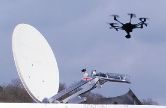 | ||||||||||
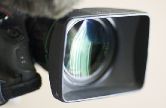 |  | 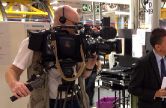 |  | |||||||
 |  |  |  | 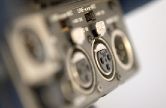 | ||||||
 | ||
January 2014 Why a satelite dish? Because it's reliable to a high degree. This is the age of 3 and 4G though - surely this is the future and the best way to connect and send video? Absolutely not. Read on... A couple of years ago I knew that I was going to get a dish, it was just a matter of time. In fact, I originally got a used Motosat unit of the kind you might see perched atop well-to-do motorhomes. In principle it was a good idea, but in practice it was very slow to send and receive data. We're talking a couple of hundred Kilobits a second here - hardly up to the challenge of broadcast news. It would literally be quicker to drive an hour back to a feed point than send using this method. Then Eutelsat launched a new satellite called KA Sat. Using the KA band carrier, this satellite has huge capacity and data throughput capabilities. It was a complete step-change and one that means cost-effiecient use of a satellite for feeding data - live or otherwise - is now within the grasp of the broadcast freelancer. It's also part of the future of cost-savings for major broadcasters as the search is on for ever cheaper ways of doing what up until now has been very expensive. For me, it was a no-brainer. Service my existing clients better and attract new ones. But what to get? A self-pointing setup was going to be in the region of £8k. You press a button and the dish does it all. It finds the satellite by itself, locks on, and you're away. A stand-alone fly-away kit could be had for a grand. Great for the roof top at the Hilton in Baghdad. Not so great for a rainy day up in the Cotswolds. Did I say I wanted cost-effective but also dry and warm... Then I got wind of something called MiniCaster from Germany. They had a new manual motorised mount that could be bolted onto a roofrack for half the price of an auto-pointer. This seemed ideal but where to see one in action? The UK dealer, TNP Broadcast in London, didn't have anything to show me. In fact, nobody did. They were so new they weren't even in the country yet. This wasn't going to be an easy decision. It was November 2013. I contacted colleagues and friends, asked advice, trawled the web for information, pictures, anything. Without seeing one in the flesh it was a difficult call to make. Buy blind and take a chance? There would be a unit at BVE in February, but I couldn't wait. Part of my contracted days to ITV were being reduced yet again - I had to be up and running and attracting new business in January. What to do? I made my mind up in mid-December. I had spoken at length to two excellent people - Steve Ryder of Stryder.tv and Paul Bridgeman of sngbroadcast.com and got the advice I needed. Steve liked the look of the MiniCaster mount and offered wisdom that can't be purchased. There isn't anything Steve doesn't know about broadcasting, satellites and very fast noisy things flashing past in the sky. A common love of Land Rovers helped, but that's another story. Paul operates out of Manchester and helped me source some used sat kit: the reflector, modem and TRIA (Transmit Receive Integrated Assembly) for an excellent reduction on the cost of new. His experience with KA shows and I am grateful for his selfless and friendly attitude. So with the decision made, the order was placed with a friendly chap called Joe Fulford at TNP. We were looking at a delivery around Christmas. In the event, there were a few delays over in Germany as I do believe this was one of the very first units to be shipped out. As soon as TNP had it, one of their drivers brought it to my door the same day. It was now late January and I had a pile of bits that I had to build into a viable, working unit to sit proudly on top of my poor old Ford Tourneo Connect. In the dim light of a winter's day, I ventured out to do battle. In truth, it was pretty easy to sort. The MiniCaster method was to have the unit facing forward with a wind deflector protecting the 70cm antennae from harm at speed. In practice, and under advice from Mr Ryder, I opted to have it rearward-facing in the traditional SNG model. After a bit of cutting and shutting, it fit quite well, and slung as low as possible under the roof bars bolted into their recepticles, the overall height addition was about 15 inches. At 2.4m safe clearance, mutli-storey car parks were most definitely now out of the equation! . | ||
I wrapped the control cables in some more protective tubing and led them aft to enter the van near the rear doors. The dish controller is 230v and simply plugs into my on-board system. I have 2 glass-mat batteries - one for the engine and one for auxillaries - powering a 1500w pure sine wave inverter. An antiquated but still capable Australian Dual-Mate battery management system monitors voltage and switches in a relay to connect the batteries for charging under power from the engine. Simply put, when the aux batt gets a bit low, you start the engine and run from the alternator. The van would be operating on an occasional use basis with no room for a generator. It wouldn't be doing all-day service like a big KU sat van. This setup was to be the 'SAS' version of satellite newsgathering: get in, do the business, get out and off to the next one. With the dish mounted, a test was surely in order? I had set up a NewsSpotter account with the good folks at sat-comm.com and with a bit of preparation as to where the satellite (aka 'bird') actually was in the sky relative to my position on the Earth's surface, deployed the dish. Love that word 'deploy'. Now when I go into the shop to pay for diesel, I don't hand over my bank card, I deploy payment... The very good news is that using the simple beeping-tone emitting from the actual TRIA itself, finding the satellite (9 degrees east of due south at an elevation of about 30 degrees) was incredibly simple. So simple I remain to this day aghast that I had actually considered spending an additional £4000 on buying a self-pointing unit. In the event I did spend a bit extra: £50 on a decent compass. And before I hear a chorus of 'but you have a compass on your iPhone!' let me ask you to do the following. Indeed, deploy your compass several times a day, and on the few occasions when it doesn't swing around wildly with false readings and sporadic guesses at where north and south exactly lay, I'll buy you a pint for every time it hits the mark to within 1 degree. Fine-tuning using the signal-to-noise ratio indicator on the web page interface for the modem is straightforward and fast. After a couple of dozen goes in varying situations, I can now find the satellite from dead start in less than two minutes, and be transmitting in less than 7. The next time your auto-pointer waves worryingly around the sky, give me a call and I can recommend a solution! With a 'Best Effort' background internet achieving anywhere from 5 to 10 Mbps down and - crucially - a constant 4 Mbps uplink, I was now good to go and send FTP files parked up anywhere in Europe. Plus an ability to book uncontended bandwidth at up to 10 meg up, my aspirations for the future with doing a live link from location were obviously within reach. True, I need some not-so-cheap hardware to do that part, but this was all part of the plan. For now, I could operate from anywhere with a guarantee of making the slot. This was going to be good | ||
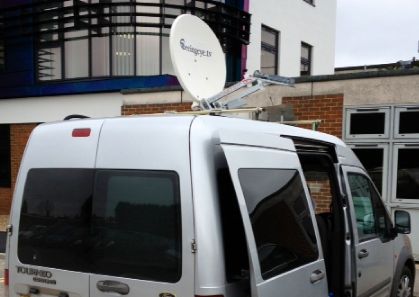 | ||||
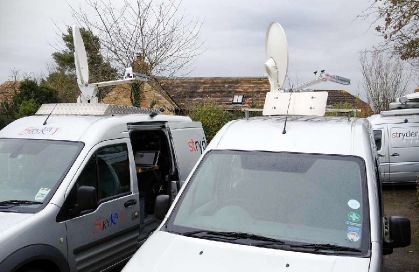 | ||||
left: StryKA1 Dawson / right: Seeing Eye MiniCaster | ||||
Posing outside Thames Valley Police HQ Oxford | ||||
4 March 2014 - Oxford ITV News Meridian reporter Mel Bloor and I were covering council funding cuts at the county council head office in Oxford. Protestors had gathered, councillors were meeting, and decisions had to be reported. Turns out it was going to be a late finish, and an early opt recording time of 4.30. By the time we'd cleared the building, some 10 minutes walk away, it would be gone 2pm. A perfect job for the dish. Oxford has 3G but being a tourist hotspot, the airwaves are heavily contended and Speedtest confimed my fears that although it was possible to send by 3G, there was no guarantee it would make the slot. This is the unreliability I dread. The satellite is a much safer bet... We headed back to the van with an 'as-live' in the can and some covering shots to edit in. It was going to be tight. While the footage was ingesting onto my MacBook Pro and FCP7, I thought of the next steps. I was to edit before the feed, so all down to me - but I could only do one thing at a time. What was the best order? We cracked on and layed down the as-live and some shots of the demo in front of the building. The editing took relatively little time, and sorting out the sound levels even less. By the time the item was ready, it had gone 4.10 pm. I jumped out and raised the dish with the manual controller, listening keenly to the TRIA beeping away. The open air car park afforded good visibility to the south, and within a few minutes the beeps changed and the satellite had been acquired. Then I climbed back inside and fine-tuned the pointing by looking at the signal-to-noise ratio indicator on the web-modem interface. Another couple of minutes and the dish had settled onto an optimum bearing.We were good to go - which was handy as we now had less than 15 minutes before the item was due to be played into the recorded opt. The 1'45" as-live fed in less than 2 minutes and as a 79 Mb file, cost all of £7.90 to ITV. If that's not good value for money, I'm a banana. (With apologies to Ian Hislop). | ||
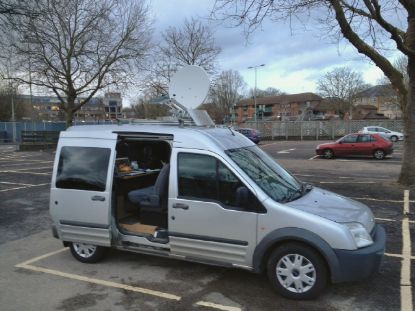 | ||
10 March 2014 - Henley River and Rowing Museum, Oxfordshire Prince Harry is visiting the museum today and I've met up with lovely ITV News reporter Mel Bloor for some filming. Harry duly arrives and is whisked into the museum in front of my camera. Sadly, that is all we will see of him for a couple of hours as there is a rota in operation and it's Trystan Scales for the BBC covering the antics inside. Before Harry arrived we managed to grab interviews with a Help for Heroes soldier and the museum manageress. So now I grab shots of the open rowing boat that said soldier and his partners in crime spent weeks in crossing the Atlantic. All good fun! We have plenty of time to kill, and I text the lunch bully producer, Hannah. 'Fancy a squirt for lunch?' 'Sure! Any SOT?' 'Yes of course'. 'When?' 'Be with you in 30 mins?' This is the beauty of the satellite. Yes there is 3G, but it's relatively slow - and as I have found previoulsy to my cost - unreliable away from population centres or known-good areas. I once bowled up to a location that I was due to film at 2 hours later. I checked 3G - it was good - 2 meg up. The studio needed to cover a hole in a package with my shots, and it was going to be late. But 2 meg up was fine - as long as I kept the shots short. After a brief chat to the reporter pulling the material together, I knew exactly what she needed and how long. The filming took place - a memorial in a cemetery - and I jumped in the van (pre-satellite dish!) and clipped up the shots. I logged onto the FTP server and dropped the video onto the window to send. The 3G speed had suddenly dropped from 2 Mbps to about 100 Kbps. Yes - 100 Kilobits. The send would - at that speed - take the best part of an hour. No amount of disconnecting and reconnectingwould bump the rate up. Nothing for it but to drive in search of better 3G. This was rural Surrey. Same thing happened once in Swindon. That's a mug's game. Never again. Back in Henley, I clipped up some shots and the entire interview with the rower - nearly 4 minutes total footage - compressed and sent in real time. I put the dish away and we went on to film the rest of Mel's package, which (as always) was a pleasure. | ||
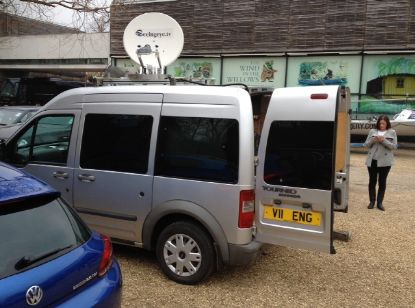 | ||||||||
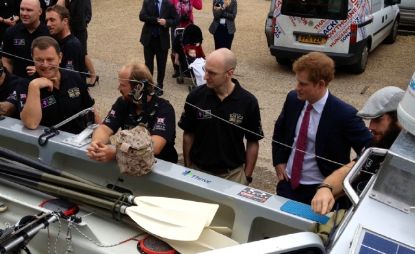 | ||||||||
Prince Harry and friends | ||||||||
Mel colour co-ordinating with the van nicely | ||||||||
13 March 2014 - Sonning, Bekshire The bridge at Sonning has been closed for weeks - the road leading up to it has been damaged and repairs have dragged on. Suddenly it's about to re-open and I'm up there to meet ITV News Meridian transport correspondent Mike Pearse. It's a late call and we're up against it. I grab some shots at the other approach on the Oxfordshire side, and then mount the GoPro in the van to record parts of the 40 minute journey, the long way around through Reading, and onto the Sonning side rendezvous. I'll later crunch this down from HD to Standard Def and give it to Mike to include in his package. I turn up on the banks of the Thames opposite the French Horn pub, but Mike is elsewhere, so I look for a suitable spot. I check the local 3G signal with the Speedtest app on the iPhone, and as I suspect - download about 1meg and upload is barely registering. But hey it's only the second decade into the 21st century right? The dish it is then. I use the iPhone which behaves itself and shows me due south. I park between a couple of trees, fairly confident that I've got a clear view of 9 degrees east. I power up the van by switching on the inverter and after the usual beeps it springs to life and off we go. Once the Apple Airport is up I latch onto the wifi with the MacBook and open the web interface. The TRIA starts beeping so I deploy the dish and raise it to my permanent marker pen marks on the feed arm pivot. Always a good starting point! Panning left a few inches and the beeps change right away - the satellite has been acquired. Literally less than two minutes and I'm on the bird. Mike arrives as I'm stuffing my face with a sandwich, and we talk about logistics. With a deadline of 4.45 for the finished item to be in the studio in Southampton, we barely have a couple of hours. Leaving the van happily sat ready to go on the satellite, we hop into Mike's car to search for a few vox pops in the village. We are lucky and get some crackers, including the local Indian restaurant whose clientele has somewhat diminished over the time the bridge has been shut. After losing the rather loud Bollywood soundtrack accompaniment, the owner gives us a good chat. Outside, a few more thoughts from the usual suspects: builder, householder, motorists. Then it's back to the van for the edit. Mike takes the rushes onto his Macbook while I start selecting some GoPro footage to crunch. He wants it sped up, so I play with that for a while. In the end the rate of 2000% seemed to do the trick and as the footage rendered, I got back on the satellite and fine-tuned the pointing. Looks like we're on the orange beam here, closer to London. Good signal, and with the Best Effort supply, getting 8 meg down and 4 up. Good to go! Mike latches onto the van's wifi - this is the first time I've tried this with a reporter's MacBook, so a little apprehensive - but no problem, he's on. The package needs some archive, and so Mike pulls this off the ITV server and over the satellite and onto his MacBook, all good. Several hundred megs of data, and all to be paid for at a cost-effective rate. Mike assures it will be. Mike edits and I crunch GoPro footage and in no time at all it's nearly 4pm. And we *still* have to film the payoff PTC. This is going to be tight. I suggest we send his package without the payoff so at least they have that in the building soonest. Mike uses Cyberduck to FTP his package - after he's squashed it down to under 100Mb in Sorenson Squeeze. Off it goes at 4 Mbps in short order. VERY happy at this. But no time to languish. It's 4.25 and we need to do the PTC about 300 yards away. Mike starts to walk, ear glued to his phone (why don't news editors actually just chill and let you get on with things instead of ringing and asking 'how you getting on?') but I shout at Mike. Car! We won't have time if we walk. I reckon we'll save 3 or 4 minutes and a lot of breath. I pile the camera, 416 and sticks onto the back seat and Mike hits the gas, seat belt alarms ringing madly in the quiet afternoon sun. One take on the PTC, pan off the 'road closed' sign to find Mike, and hold.... Back to the van, tape in the DSR-11, into the MacBook, and he does his thing in AVID and Sorenson. 4.40 and it's going. At 4 Mbps upload, a compressed file sends in more or less real time. In 12 seconds it's gone and we wait nervously to see it appear on the FTP server... The piece made - just. They put the opt back 2 minutes for us, but it made. | ||
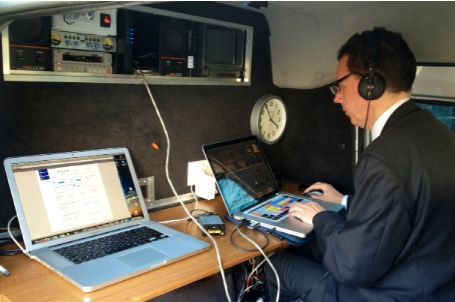 | ||||
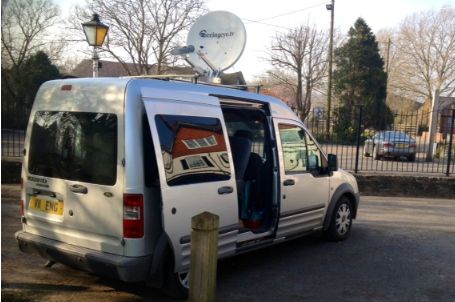 | ||||
GoPro Hero 2 filmed sections of journey in 1080p, wi-fi backpac sending feed to iPhone mounted on dash, crunched down into SD in FCP7, output via Compressor for web repro here as MP4 file. | ||
14 March 2014 - Bicester, Oxfordshire Big gas leak in Bicester today, but only got up there at 4pm for a 6 pm deadline. Bog-standard shots of a police road block in the can, and a quick check of 3G in the area. Download speed 5 meg, upload a half of one - abysmal. The wind was up with skies darkening as a cold front was imminent - a good test for the dish! Took slightly longer finding it today - my fault. I have markings on the feed arm at the pivot with the upright dish mount so that when the dish is raised, I know pretty much when it is looking up at about 30 degrees elevation. I checked the azimuth angle with my little yellow Suunto compass and swung the dish around through 25 or so degrees, back and forth, raising it a little each time. No go! Pondered it for a minute and was about to check the azimuth with the iPhone compass when I suddenly thought of road camber. The van was parked on a small side road and when I stood facing it, sure enough, a slight camber. Quick mental correction, dish looking too high. Dropped it down a bit and tried again. This time I found the bird in a minute. Fed two and a half minutes of rushes in a little over that time - not a moment of hesitation or interruption from the wind. Very happy: shots in the studio for use shortly after 5pm, ready for transmission at 6. Next! | ||
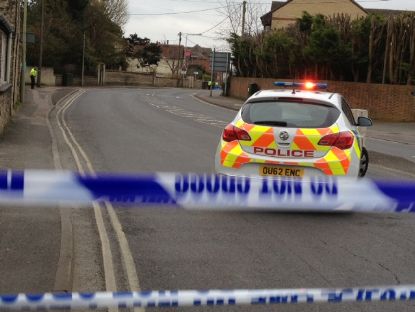 | ||||
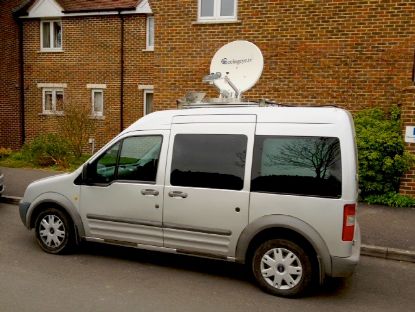 | ||||
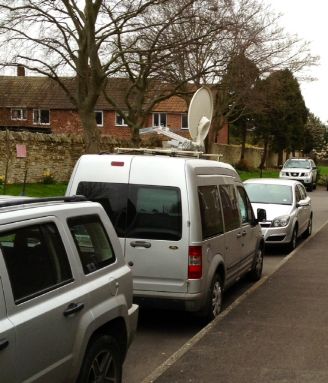 | ||||
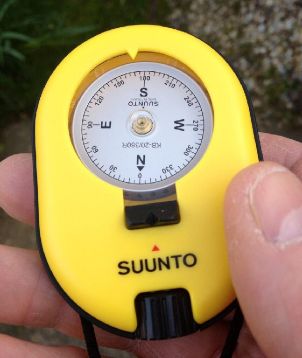 | ||||
28 April 2014 Out with Mel Bloor today on a big story slated for tomorrow involving harrowing interviews with bereaved. Not pleasant. Inbetween, some GVs of a cul-de-sac where some lad was injured in a brawl. Mel got some practice in with her new PMW-200 although recording in SD for Meridian. Later, we had finished shooting a PTC at 1pm and the desk rang to see if we could send the cul-de-sac shots for the lunch bully! Speedtest of 3G and the usual sub-1 M/bit upstream speed typical of edge-of-town housing estates. Glance at the watch - realistically had about 30 mins to get it in the studio. Trawl local houses for a decent BT-with-Fon wifi signal? Or put the dish up? Well, no prizes for guessing. Was parked on quite a slope facing downhill, but looking at the compass, had a clear view of the bird at 5 o'clock or so. Powered up the van and set the dish to a rough heading. The problem with parking on a slope is that unless the satellite is directly fore or aft of the direction of slope, then any movement in searching the horizontal aspect - the azimuth - is not done parallel to the horizon. I hoped it wouldn't be a problem. Mercifully, it wasn't. Took me about 10 minutes to acquire the signal, one of my longest searches. The slope meant my hardware pen guide was pretty much useless. I really need to get the spirit-level gauges set up properly on the feed arms - mental note to do that soon! I also note that once on the satellite, any slight movement through climbing inside the van means it knocks off centre slightly so I tend to fine tune sat aboard. The next van will have a steadying jack system. Imported the Avi files from the SD recordings made by Mel on her SxS card, dragged a few clips onto the FCP timeline and crunched down a minute's worth of shots through Compressor. Sent at 4 M/bits up and no problem at all. In-house in under 25 minutes from power-up. Well pleased with this, especially as I haven't used the dish in a couple of weeks. | ||
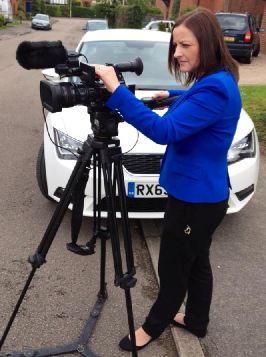 | ||||
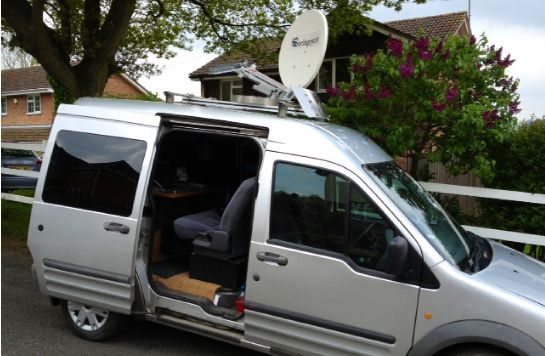 | ||||
2 May 2014 Is this a world record for satellite acquisition? To Streatley in Berkshire for a story about something nasty dripping out of taps. Nerve centre seemed to be a local pub so I parked up in what seemed to be a reasonable clearing, and knew south was roughly behind me. Pressed the button and raised the dish and was onto the Eutelsat KA in less than 15 seconds. The van was parked with its arse facing exactly 9 degrees east of south, right on the money. In fact I later tested how long it took to raise the dish from fully down, to the 30 degree position and it was about 10 seconds. Kindly beat that Mr. Dawson ;-) | ||
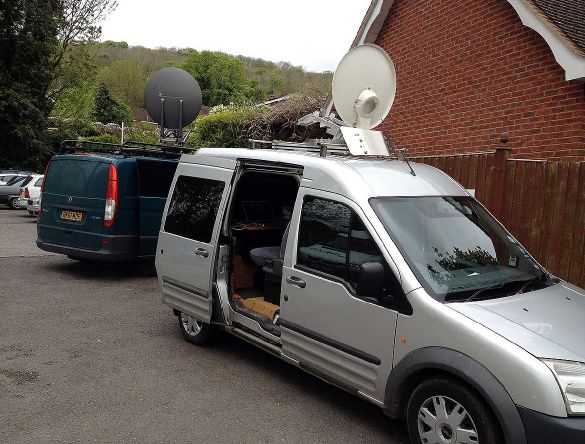 | ||
Have I built the new PMW-450? Not a satellite blog entry really, but thought this of interest to people running a new Sony PMW-400 and who are frustrated with the quality of the supplied viewfinder. When I got a DVCam DSR-450 back in 2006 I was aghast when I peered down the supplied viewfinder in the showroom. It really was crap. So I shelled out the extra couple of grand for an XDCAM mono viewfinder - the DXF-20W. It was much better in terms of resolution and magnification - the image was big and bright, and you could actually nail focus with it very easily. Fast forward to this year. Enter the PMW-400. The supplied viewfinder really is a P.O.S. in terms of focus and contrast - the peaking settings are mind-bogglingly awful and it's either far too much or not enough. Mix it with some zebra-patterning and it's a total mare. But what's this? I can use my DXF-20W with my new camera? What's the catch? For PMW-500 owners, a wry smile. How am I going to survive without any reference to colour output from the camera? And framing with colour opens up a whole new world of creativity. Well, that's a load of Bolex. I've been framing in colour for years. Seeing the scene with my own eyes before looking down the viewfinder, and knowing the colours of the objects is second-nature to any camera operator worth their salt. Only in the most develish flower arrangement where one red rose sits amongst dozens of white ones will an extra glance or two be needed to frame up on the money. And now I can just glance at the colour monitor on the rear of the 400 to confirm. A colour monitor? Why not? After rumbling around in kit drawers I found what I was looking for: an Eekbay Cheapshit ® 4 and a half inch 12v monitor.. A few tests and hey presto. Velcro'd to the back with just a power chord and a BNC-to-RCA going into the thing and I have a smart little monitor with a big bonus. If you work on news these days, you'll know what 'can you just chuck a few questions' means. If there's more than one interview, then it's good to get them looking to different sides, right? On the 'no man's land' of camera right, a veritable cameraman's wasteland usually occupied by journalists, I can now stand and keep an eye on the framing by whipping the colour monitor over to the opposite side. Nice little win there. And what of the DXF-20W finder? It is much easier to focus using it, the peaking seems crisper and the brightness and contrast problems of the original 400 finder are gone. Sure, I'll carry it as a spare, but I expect to be much happier with the 20W. We shall see. I should add that I got the 400 with a massive discount, so a used 500 would have been more expensive - happy to compromise due to cost... | ||
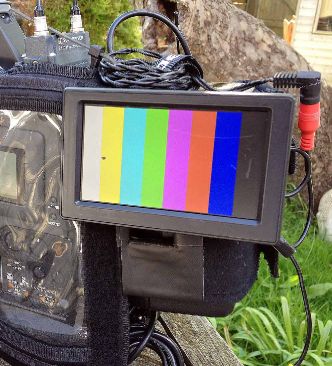 | ||||||
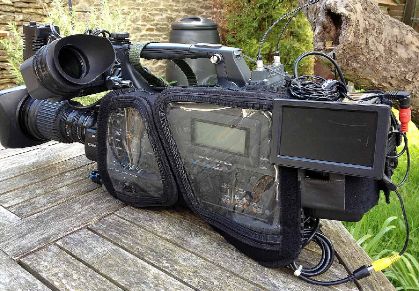 | ||||||
Little bit of tidying to do | ||||||
Eekbay Cheapshit ® monitor with dead pixels! Might get something slightly smaller. | ||
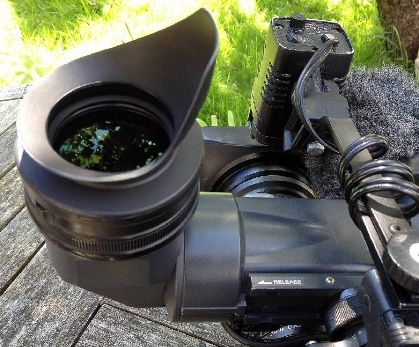 | ||||||
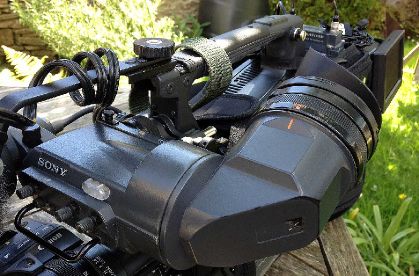 | ||||||
DXF-20W finder | ||||||
If you've never used one of these, they are brilliant. For using with both eyes, you simply re-focus finder barrel just below rubber eyecup, and stereoscopic effect of human vision allows left eye to see right side of screen, and right eye to see left side of screen. Combined image melds perfectly and works well. | ||
As time goes by, changes happen. I've transferred the SNG operation over to a Land Rover Defender as of January 2015 and you can continue reading about that by following this link. | ||